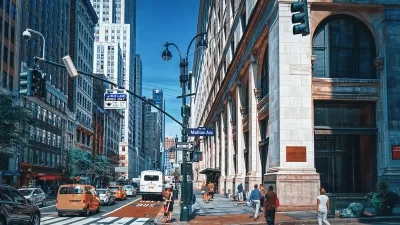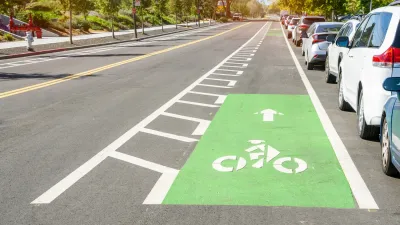The plan to reimagine Manhattan’s Third Avenue to make it safer for pedestrians and cyclists is being applauded by advocates, but some say the city should go further to provide more space for multimodal transportation.

A New York City street that some call “an inhospitable and dangerous traffic sewer” will soon be reimagined as a multimodal corridor, per a Streetsblog NYC article by Julianne Cuba.
After months of advocacy from local pols and activists — and a shiny spread in New York Magazine showcasing what a reimagined current seven-lane Third Avenue could be — the Department of Transportation on Wednesday night unveiled its plans to a Manhattan Community Board 8 panel to take away two lanes of moving traffic in order to make room for a protected bike lane and designated bus lane on the corridor between E. 59th and E. 96th streets.
According to Cuba, “The plan, which also includes taking away parking spaces near intersections to allow for pedestrian islands and shorter crossing times, will not only help cyclists, but also pedestrians and the more than 50,000 bus riders daily, who currently suffer from exhaustingly slow commutes on the more than 150 buses that traverse the thoroughfare.”
While approving of the new changes, some advocates want the city to install additional protective bike infrastructure and wider sidewalks, with the article indicating that “it’s well documented that the existing protected bike lanes on First and Second avenues are already overcrowded and in need of widening.”
Cuba notes that the project is expected to break ground next year, and plans for the rest of Third Avenue are yet to be finalized.
FULL STORY: Manhattan Panel Cheers City’s Third Ave. Redesign (Though Some Wish it Was Bolder)

Planetizen Federal Action Tracker
A weekly monitor of how Trump’s orders and actions are impacting planners and planning in America.

Restaurant Patios Were a Pandemic Win — Why Were They so Hard to Keep?
Social distancing requirements and changes in travel patterns prompted cities to pilot new uses for street and sidewalk space. Then it got complicated.

Map: Where Senate Republicans Want to Sell Your Public Lands
For public land advocates, the Senate Republicans’ proposal to sell millions of acres of public land in the West is “the biggest fight of their careers.”

Maui's Vacation Rental Debate Turns Ugly
Verbal attacks, misinformation campaigns and fistfights plague a high-stakes debate to convert thousands of vacation rentals into long-term housing.

San Francisco Suspends Traffic Calming Amidst Record Deaths
Citing “a challenging fiscal landscape,” the city will cease the program on the heels of 42 traffic deaths, including 24 pedestrians.

California Homeless Arrests, Citations Spike After Ruling
An investigation reveals that anti-homeless actions increased up to 500% after Grants Pass v. Johnson — even in cities claiming no policy change.
Urban Design for Planners 1: Software Tools
This six-course series explores essential urban design concepts using open source software and equips planners with the tools they need to participate fully in the urban design process.
Planning for Universal Design
Learn the tools for implementing Universal Design in planning regulations.
Heyer Gruel & Associates PA
JM Goldson LLC
Custer County Colorado
City of Camden Redevelopment Agency
City of Astoria
Transportation Research & Education Center (TREC) at Portland State University
Camden Redevelopment Agency
City of Claremont
Municipality of Princeton (NJ)





























